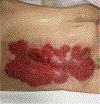Ileostomy adenocarcinoma in Crohn's disease
- PMID: 32144530
- PMCID: PMC7957826
- DOI: 10.1007/s00384-020-03554-6
Ileostomy adenocarcinoma in Crohn's disease
Abstract
Purpose: Adenocarcinoma of an ileostomy is rare with less than 50 reported cases in the literature. Ileostomy adenocarcinoma in Crohn's disease is even more rare, with only 4 reported cases. We present a case of ileostomy adenocarcinoma with lymph node metastasis occurring 51 years after proctocolectomy and Brooke ileostomy in a female with Crohn's disease. This case represents the longest documented interval between Brooke ileostomy and ileostomy adenocarcinoma diagnosis and summarizes clinical signs that warrant biopsy of a peristomal plaque to differentiate adenocarcinoma from clinical mimics such as pyoderma gangrenosum (PG).
Methods: Clinical, histological, and surgical patient data were reviewed. A literature review of adenocarcinoma arising from ileostomy sites was performed.
Results: We report a case of a 67-year-old woman that presented with a peristomal skin lesion developing over 10 years. After multidisciplinary discussion between gastroenterology, colorectal surgery, and dermatology, ileoscopy revealed moderately differentiated, invasive adenocarcinoma arising from the ileostomy site. Wide surgical excision and en bloc resection of the peristomal lesions were performed, and the final pathology revealed lymph node metastasis. The patient is currently undergoing adjuvant chemotherapy.
Conclusions: Clinicians should maintain a high level of suspicion when ileostomy patients develop a peristomal lesion.
Keywords: Colonic adenocarcinoma; Crohn’s disease; Ileostomy; Peristomal.
Conflict of interest statement
Figures





References
-
- Metzger PP, Slappy AJ, Chua HK, Menke DM (2008) Adenocarcinoma developing at an ileostomy: report of a case and review of the literature. Dis Colon Rectum 51(5):604–609 - PubMed
-
- Brooke B (1952) The management of an ileostomy: including its complications. Lancet 260(6725):102–104 - PubMed
-
- Gadacz T, McFadden D, Gabrielson E, Ullah A, Berman J (1990) Adenocarcinoma of the ileostomy: the latent risk of cancer after colectomy for ulcerative colitis and familial polyposis. Surgery 107(6):698–703 - PubMed
-
- Sigler L, Jedd FL (1969) Adenocarcinoma of the ileostomy occurring after colectomy for ulcerative colitis. Dis Colon Rectum 12(1): 45–48 - PubMed
-
- Suarez V, Alexander-Williams J, O’Connor HJ, Campos A, Fuggle WJ, Thompson H, Enker WE, Greenstein AJ (1988) Carcinoma developing in ileostomies after 25 or more years. Gastroenterology 95(1):205–208 - PubMed
Publication types
MeSH terms
Grants and funding
LinkOut - more resources
Full Text Sources
Medical
Research Materials

